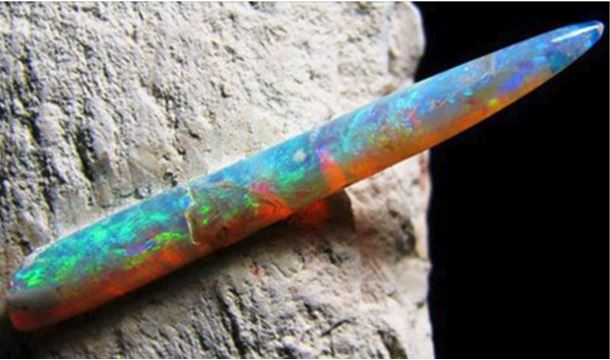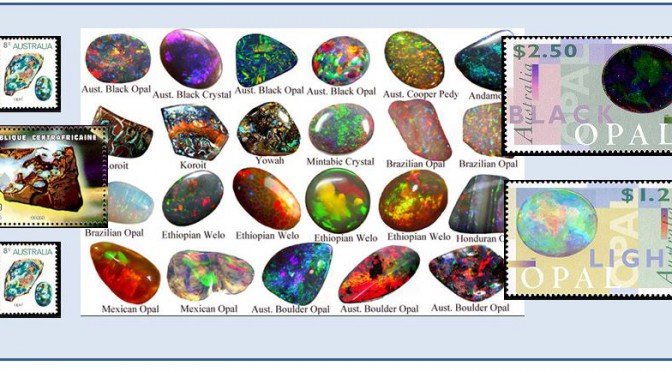October is another month with two official birthstones. If you are partial to wondrously terminated hard crystalline faceted gemstones, perhaps tourmaline would be your preferred choice. But, if you like the rainbow play of colors offered by opal, then stones cut to display the remarkable lustrous character of precious opal may touch your fancy. Since I’ve already written about tourmaline, let’s focus on opal in this birthstone review.
Opal is a hydrated amorpous form of silica, a hardened gel of silica and water with a chemical composition of SiO2 · nH2O. Water content can range from 3-21%, but most opal carries 6-10% water locked into layers of closely packed spheres comprised of silica. Technically, opal is not a mineral because it does not have a fixed elemental composition or a crystalline structure. It is classified as a mineroid, similar to pearl. Where pearl involves calcium carbonate (aragonite) interlocking with organic matter opal contains silica spheres and water.
Opal is found in a variety of geological settings, but all of them involve low temperature near surface conditions. The most common occurrence involves simple rain water percolating into silica-rich rocks in generally dry regions. When evaporation occurs silica becomes saturated in the remaining water. Under low temperature and low pressure conditions this produces an opaline form of silica where very small spheres of silica are stacked like ping pong balls in a box with bits of water interlocked into the structure . In similar settings, but at higher temperatures and deeper burial, crystalline quartz would result.
Not all opal contains the internal structure required to diffract light and display the characteristic play-of-color of precious opal. The spheres in common opal are either too large or too irregular in size to permit light to be diffracted. Similar to the play-of-color seen in pearl, it is the regularity of these silica spheres and the thickness of the layers they form that dictate the quality and intensity of the diffraction colors observed. Interestingly, the exact cause of the rainbow colors in opal was not known until the 1960’s and the invention of the electron microscope.
Opal can fill fractures or vugs in the shallow underground or it can replace existing rock, mineral, or even fossil material. Silica-rich rocks include sandstone, silicic volcanic or metamorphic rocks, and even petrified wood.

Australia dominates the opal market, with over 80% of historic worldwide production coming from the near desert environs in the state of South Australia. That dominance may be dropping though as high quality opal is being found in Ethiopia and Brazil, and to a lesser extent in eastern Europe, Nevada, Indonesia and Latin America.

References:
Gemological Institute of American webpage
Guide to Gems, 2003, Firefly Books Inc., p. 173-174
